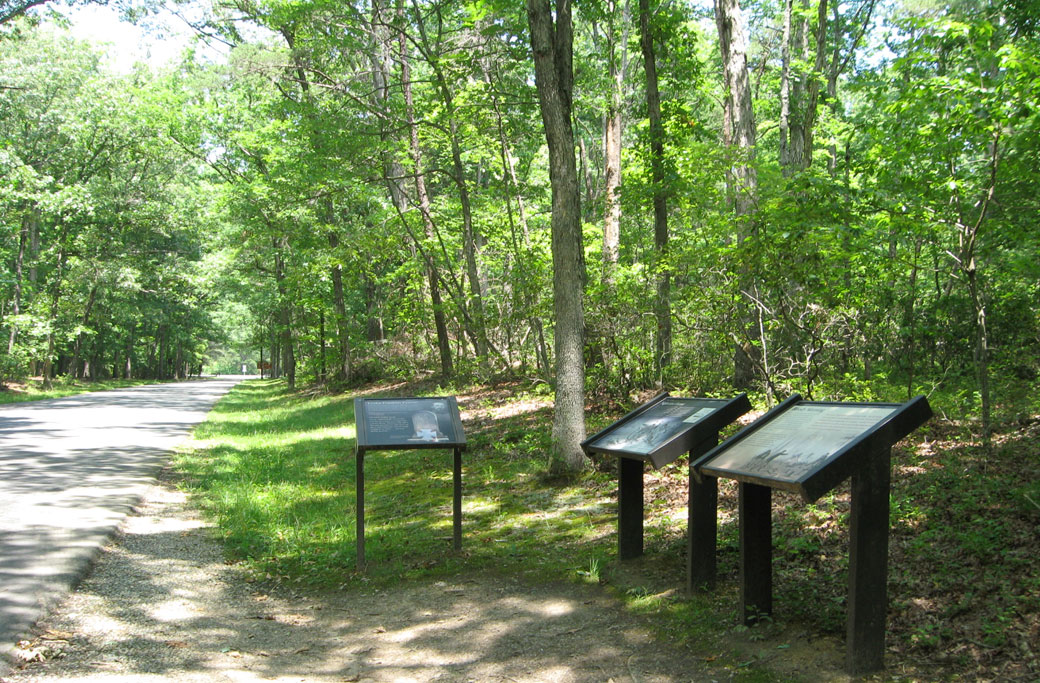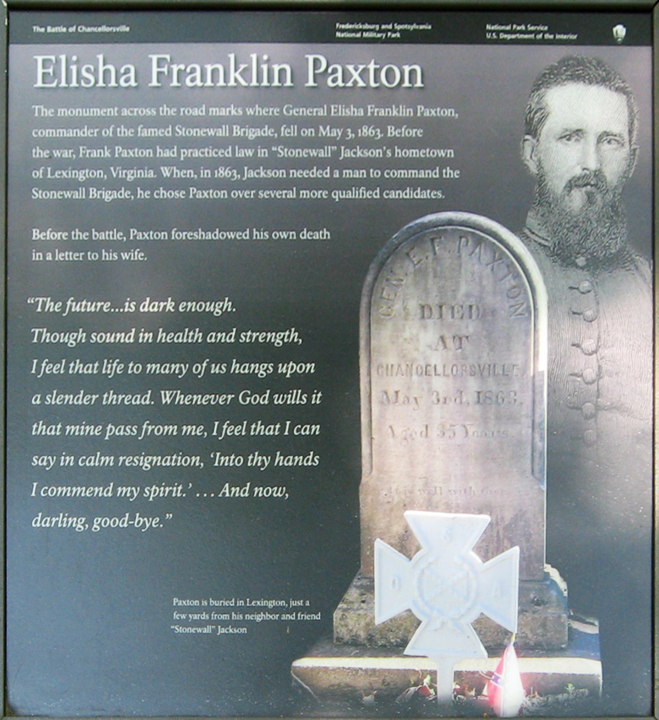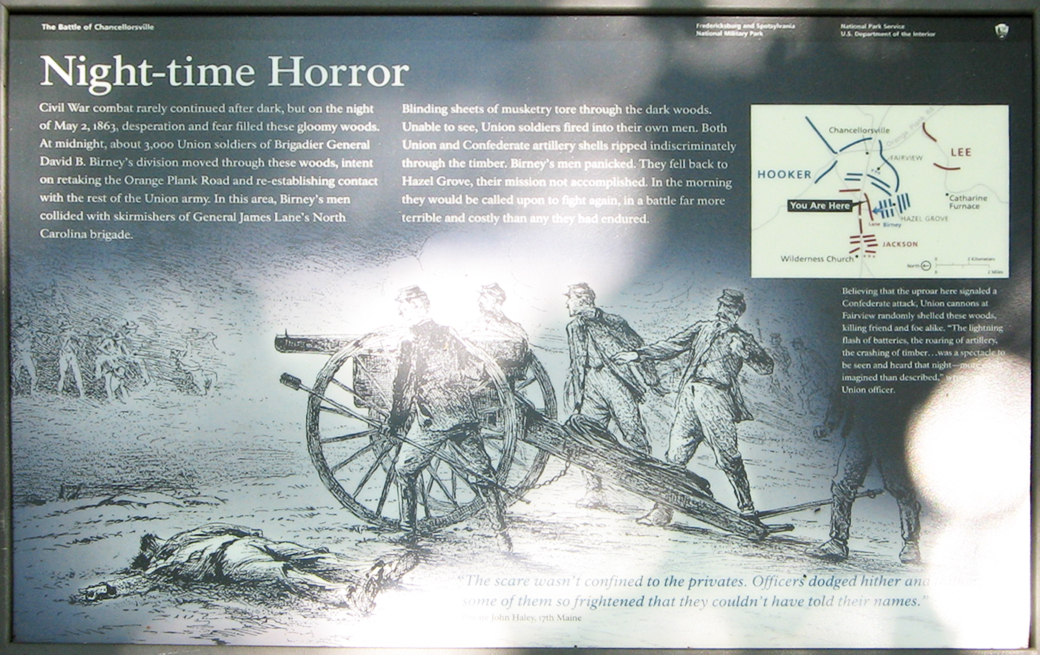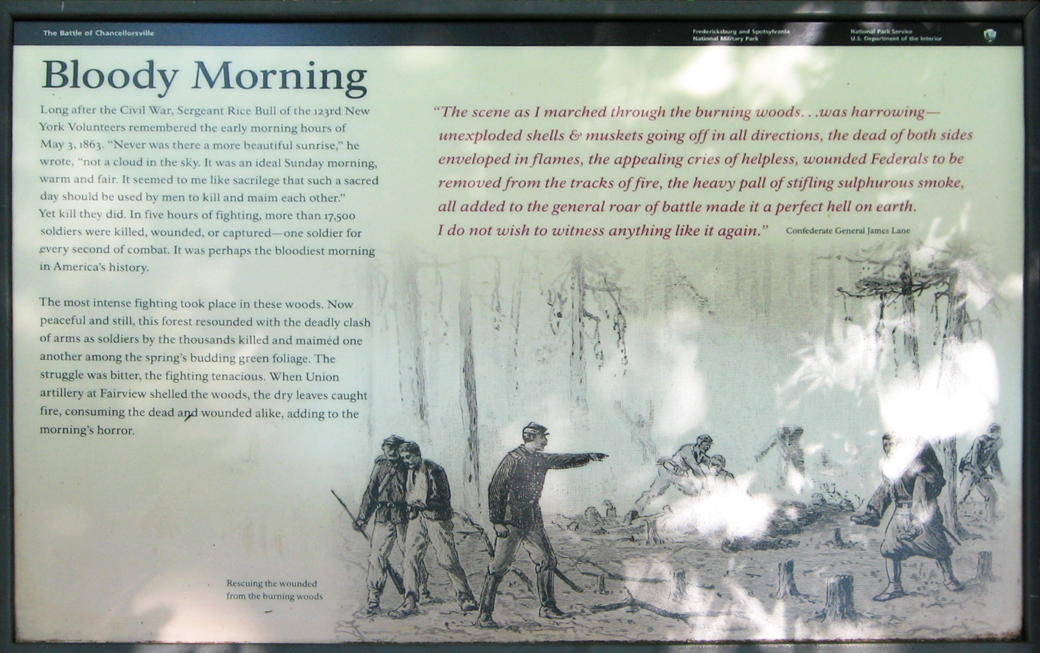Battle of Chancellorsville • Tour the Battlefield • Monuments & Markers • Battle Facts • The Armies
Three wayside markers are on the east side of Stuart Avenue across from the monument to Confederate Brigadier General Elisha Paxton. (see map below)

The “Elsha Franklin Paxton” marker is on the left, with the “Night-time Horror” and “Bloody Morning” markers on the right. The Paxton monument is across the road on the left, out of frame.
Elisha Franklin Paxton wayside marker
Text from the marker:
Elisha Franklin Paxton
The monument across the road marks where Elisha Franklin Paxton, commander of the famed Stonewall Brigade, fell on May 3, 1863. Before the war, Frank Paxton had practiced law in “Stonewall” Jackson’s hometown of Lexington, Virginia. When, in 1863, Jackson needed a man to command the Stonewall Brigade, he chose Paxton over several more qualified candidates.
Before the battle, Paxton foreshadowed his own death in a letter to his wife.
“The future… is dark enough. Though sound in health and strength, I feel that life to many of us hangs upon a slender thread. Whenever God wills it that mine will pass from me, I feel that I can say in calm resignation, ‘Into the hands I commend my spirit.’… and now, darling, good-bye.”
Text from the caption to the photo:
Paxton is buried in Lexington, just a few yards from his neighbor and friend “Stonewall” Jackson.

Night-time Horror wayside marker
Text from the marker:
Night-time Horror
Civil War combat rarely continued after dark, but on the night of May 2, 1863, desperation and fear filled these gloomy woods. At midnight, about 3,000 Union soldiers of Brigadier General David B. Birney’s division moved through these woods, intent on retaking the Orange Plank Road and re-establishing contact with the rest of the Union army. In this area, Birney’s men collided with skirmishers of General James Lane’s North Carolina brigade.
Blinding sheets of musketry tore through the dark woods. Unable to see, Union soldiers fired into their own men. Both Union and Confederate artillery shells ripped indiscriminately through the timber. Birney’s men panicked. They fell back to Hazel Grove, their mission not accomplished. In the morning they would be called upon to fight again, in a battle far more terrible and costly than any they had endured.
“The scare wasn’t confined to the privates. Officers dodged hither and thither, some of them so frightened they couldn’t have told their names.”
Private John Haley, 17th Maine
Text from the caption to the drawing:
Believing that the uproar here signaled a Confederate attack, Union cannons at Fairview randomly shelled these woods, killing friend and foe alike. “The lightning flash of the batteries, the roaring of artillery, the crashing of timber… was a spectacle to be seen and heard that night-more to be imagined than described,” wrote one Union officer.

Bloody Morning wayside marker
Text from the marker:
Bloody Morning
Long after the Civil War, Sergeant Rice Bull of the 123rd New York Volunteers remembered the early morning hours of May 3, 1863. “Never was there a more beautiful sunrise,” he wrote, “not a cloud in the sky. It was an ideal Sunday morning, warm and fair. It seemed to me like sacrilege that such a sacred day should be used by men to kill and maim each other.” Yet kill they did. In five hours of fighting, more than 17,500 soldiers were killed, wounded, or captured – one soldier for every second of combat. It was perhaps the bloodiest morning in America’s history.
The most intense fighting took place in these woods. Now peaceful and still, this forest resounded with the deadly clash of arms as soldiers by the thousands killed and maimed one another among the spring’s budding green foliage. The struggle was bitter, the fighting tenacious. When Union artillery at Fairview shelled the woods, the dry leaves caught fire, consuming the dead and wounded alike, adding to the morning’s horror.”
The scene as I marched through the burning woods… was harrowing — unexploded shells & muskets going off in all directions, the dead of both sides enveloped in flames, the appealing cries of helpless, wounded Federals to be removed from the tracks of fire, the heavy pall of stifling, sulphurous smoke, all added to the general roar of battle made it a perfect hell on earth. I do not wish to witness anything like it again.”
Confederate General James Lane
Text from the caption to the drawing:
Recovering the wounded from the burning woods.

Location of the markers
The Paxton wayside markers are on Stuart Drive about 200 yards south of Plank Road (Virginia Route 3) and the Visitor Center (38°18’32.0″N 77°39’06.7″W). The Paxton monument is on the west side of the road and the wayside markers are on the east side.
